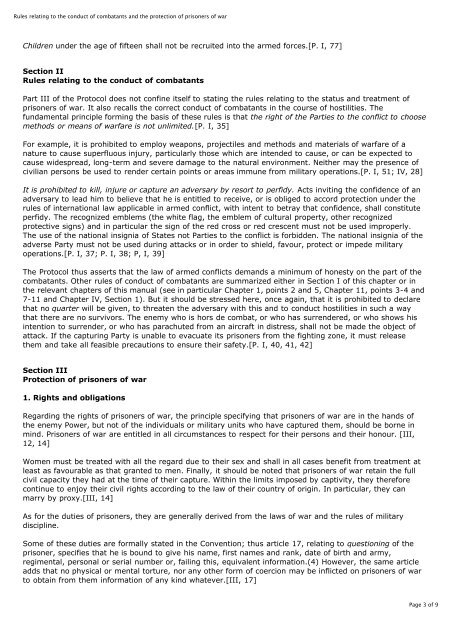The Law of War
The Law of War
The Law of War
You also want an ePaper? Increase the reach of your titles
YUMPU automatically turns print PDFs into web optimized ePapers that Google loves.
Rules relating to the conduct <strong>of</strong> combatants and the protection <strong>of</strong> prisoners <strong>of</strong> war<br />
Children under the age <strong>of</strong> fifteen shall not be recruited into the armed forces.[P. I, 77]<br />
Section II<br />
Rules relating to the conduct <strong>of</strong> combatants<br />
Part III <strong>of</strong> the Protocol does not confine itself to stating the rules relating to the status and treatment <strong>of</strong><br />
prisoners <strong>of</strong> war. It also recalls the correct conduct <strong>of</strong> combatants in the course <strong>of</strong> hostilities. <strong>The</strong><br />
fundamental principle forming the basis <strong>of</strong> these rules is that the right <strong>of</strong> the Parties to the conflict to choose<br />
methods or means <strong>of</strong> warfare is not unlimited.[P. I, 35]<br />
For example, it is prohibited to employ weapons, projectiles and methods and materials <strong>of</strong> warfare <strong>of</strong> a<br />
nature to cause superfluous injury, particularly those which are intended to cause, or can be expected to<br />
cause widespread, long-term and severe damage to the natural environment. Neither may the presence <strong>of</strong><br />
civilian persons be used to render certain points or areas immune from military operations.[P. I, 51; IV, 28]<br />
It is prohibited to kill, injure or capture an adversary by resort to perfidy. Acts inviting the confidence <strong>of</strong> an<br />
adversary to lead him to believe that he is entitled to receive, or is obliged to accord protection under the<br />
rules <strong>of</strong> international law applicable in armed conflict, with intent to betray that confidence, shall constitute<br />
perfidy. <strong>The</strong> recognized emblems (the white flag, the emblem <strong>of</strong> cultural property, other recognized<br />
protective signs) and in particular the sign <strong>of</strong> the red cross or red crescent must not be used improperly.<br />
<strong>The</strong> use <strong>of</strong> the national insignia <strong>of</strong> States not Parties to the conflict is forbidden. <strong>The</strong> national insignia <strong>of</strong> the<br />
adverse Party must not be used during attacks or in order to shield, favour, protect or impede military<br />
operations.[P. I, 37; P. I, 38; P, I, 39]<br />
<strong>The</strong> Protocol thus asserts that the law <strong>of</strong> armed conflicts demands a minimum <strong>of</strong> honesty on the part <strong>of</strong> the<br />
combatants. Other rules <strong>of</strong> conduct <strong>of</strong> combatants are summarized either in Section I <strong>of</strong> this chapter or in<br />
the relevant chapters <strong>of</strong> this manual (see in particular Chapter 1, points 2 and 5, Chapter 11, points 3-4 and<br />
7-11 and Chapter IV, Section 1). But it should be stressed here, once again, that it is prohibited to declare<br />
that no quarter will be given, to threaten the adversary with this and to conduct hostilities in such a way<br />
that there are no survivors. <strong>The</strong> enemy who is hors de combat, or who has surrendered, or who shows his<br />
intention to surrender, or who has parachuted from an aircraft in distress, shall not be made the object <strong>of</strong><br />
attack. If the capturing Party is unable to evacuate its prisoners from the fighting zone, it must release<br />
them and take all feasible precautions to ensure their safety.[P. I, 40, 41, 42]<br />
Section III<br />
Protection <strong>of</strong> prisoners <strong>of</strong> war<br />
1. Rights and obligations<br />
Regarding the rights <strong>of</strong> prisoners <strong>of</strong> war, the principle specifying that prisoners <strong>of</strong> war are in the hands <strong>of</strong><br />
the enemy Power, but not <strong>of</strong> the individuals or military units who have captured them, should be borne in<br />
mind. Prisoners <strong>of</strong> war are entitled in all circumstances to respect for their persons and their honour. [III,<br />
12, 14]<br />
Women must be treated with all the regard due to their sex and shall in all cases benefit from treatment at<br />
least as favourable as that granted to men. Finally, it should be noted that prisoners <strong>of</strong> war retain the full<br />
civil capacity they had at the time <strong>of</strong> their capture. Within the limits imposed by captivity, they therefore<br />
continue to enjoy their civil rights according to the law <strong>of</strong> their country <strong>of</strong> origin. In particular, they can<br />
marry by proxy.[III, 14]<br />
As for the duties <strong>of</strong> prisoners, they are generally derived from the laws <strong>of</strong> war and the rules <strong>of</strong> military<br />
discipline.<br />
Some <strong>of</strong> these duties are formally stated in the Convention; thus article 17, relating to questioning <strong>of</strong> the<br />
prisoner, specifies that he is bound to give his name, first names and rank, date <strong>of</strong> birth and army,<br />
regimental, personal or serial number or, failing this, equivalent information.(4) However, the same article<br />
adds that no physical or mental torture, nor any other form <strong>of</strong> coercion may be inflicted on prisoners <strong>of</strong> war<br />
to obtain from them information <strong>of</strong> any kind whatever.[III, 17]<br />
Page 3 <strong>of</strong> 9

















